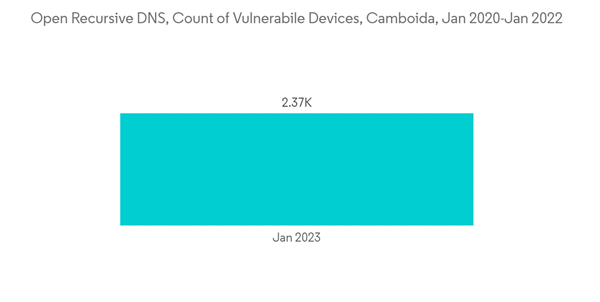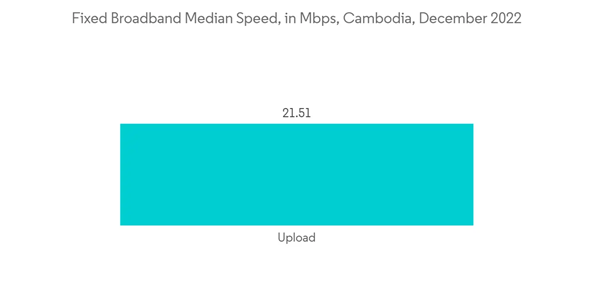The Cambodian ICT market is expected to register a CAGR of 5.3% over the forecasted period. The increasing usage of IoT-based devices across several industries, including consumer electronics, military, agriculture, and construction, significantly drives the ICT technology industry. The market is also growing because the government is spending more on keeping up its advanced infrastructure and making sure that the country's many modernization and improvement projects are done right.
In March 2022, Cambodia's best internet service provider (ISP), EZECOM, teamed up with Amazon Web Services (AWS) to offer the digital expertise of a leading cloud service provider in computing, storage, database, security, management, and networking.
In April 2022, Alibaba Cloud, a prominent cloud service provider, will officially launch in Cambodia, as the Chinese e-commerce and tech giant hopes to make its mark on a rapidly growing industry in the Kingdom. Cloud services give customers access to infrastructure, platforms, or software that is hosted by a third party and made available over the internet.
This product will be delivered within 2 business days.
Key Highlights
- The Cambodia Digital Government Policy 2022-2035 is a strategic plan that reflects the Royal Government's long-term vision and acts as a blueprint for complete digital government transformation. This way, short-term, medium-term, and long-term priority actions are arranged cohesively and comprehensively by digital technology advancement, Cambodian development, and national and international best practices. By doing these top priorities, Cambodia will move up on the E-Government Development Index, which is put out every two years by the UN Department of Economic and Social Affairs.
- Visa highlights a fast-changing payment landscape in Cambodia in its Consumer Payment Attitudes study, with cash losing ground to digital alternatives. According to the report, fourteen percent of Southeast Asian customers do not use any money, with Cambodia (36%) leading the way. The rapid growth of digital payments is propelling the development of e-commerce in Cambodia. According to the National Bank of Cambodia (NBC), Cambodia had 13.6 million mobile payment customers last year, increasing 42% from 9.56 million in the previous two years.
- According to GSMA Intelligence, there were 22.06 million cellular mobile connections in Cambodia at the beginning of last year. Further, mobile connections in Cambodia were comparable to 129.3 percent of the total population in January 2022. Moreover, according to Hootsuite, in January last year, Cambodia had 13.44 million internet users. At the start of the previous year, Cambodia's internet penetration rate was 78.8 percent of the total population.
- According to the Royal Government of Cambodia, the global trend of the Fourth Industrial Revolution, combined with the spread of COVID-19, has prompted Cambodia to accelerate its socio-economic development by utilizing digital technology as a catalyst for new growth sources to achieve its vision of becoming a higher middle-income country by 2030 and a high-income nation by 2050. In this way, the Cambodia Digital Economy and Society Policy Framework 2021-2035 was made in response to the Fourth Industrial Revolution. It has three main pillars: digital citizens, digital government, and digital business. Building a digital government must start first to encourage the adoption and use of digital technology and digital transformation in the economy and society as a whole.
- As ICT infrastructure policies are revitalized, information security becomes an increasingly critical concern in Cambodia and worldwide. Cambodia has tried to set up a national cyber security base through the CamCERT organization. However, there are some problems, such as a lack of a comprehensive cyber security system to ensure the reliability of ICT services, a lack of relevant laws, regulations, policies, standards, and norms, a lack of cyber security knowledge and know-how, and an outdated cyber security infrastructure.
Cambodia ICT Market Trends
Cybersecurity is Expected to Observe a Significant Growth
- The surge in demand for security protocols and procedures due to rising data theft is actively driving the expansion of the Cambodian cyber security market. The industry is expanding primarily due to complaints from cyber enterprises about data breaches, hacking efforts, cyber phishing, foreign espionage, etc., increased use of cloud-based services, and online data exchange and storage. Bringing your own device to work (BYOD) is becoming more popular. As a result, businesses are asking for more data protection, and it's important to keep an eye on how important company data is shared through BYOD devices. This all helps the Cambodian cyber security market grow.
- As the digital government streamlines work processes across the country, ensuring good security and sustainability for technology use is critical. Cyberattacks, national security concerns, breaches of classified information, force majeure, and other significant risks are major. So, the government must 1) keep a secure and resilient infrastructure that works together, 2) back up data for digital government service operations, and 3) improve digital security across ministries and organizations.Such concerns would push the country to invest more in cybersecurity solutions,
- In December 2022, in Phnom Penh, the Japan International Cooperation Agency (JICA) signed a Record of Discussions with the Government of the Kingdom of Cambodia for the Initiative for Improvement of Cyber Resilience, a technical cooperation project. CamCERT, a national CSIRT in Cambodia, is linked with the Ministry of Posts and Telecommunications's Department of ICT Security. The goal of the project is to help the Department of ICT Security get better at cyber security and make Cambodia's digital society more secure in the future.
- In November last year, the Ministry of Posts and Telecommunications prepared a cyber security law to decrease cybercrime, secure individual data, and defend Cambodia's public and private institutions. Hackers threaten Cambodia as much as they do the rest of the world. The government is making significant efforts to develop a national cyber security infrastructure and recruit specialists to monitor cyberattacks to preserve cyber security and combat cybercrime.
- Open recursive DNS is a severe security flaw since it allows the system to be utilized in a DNS amplification attack, in which someone spoofs an IP address and queries the DNS server for an answer. For instance, according to Cyber Green, in Cambodia in January 2022, 2365 devices will be vulnerable to this attack.
The IT and Telecom Sector is Expected to Drive the Market
- During the projection period, the IT infrastructure sector is expected to hold significant market shares and grow rapidly. The market is being driven by the growing requirement to integrate complex IT infrastructure and digitization. The Internet of Things (IoT) is the wave of the future, but as it becomes more widespread, more vital systems will be vulnerable to malware attacks and compromised for significant sums of money. So, over the next few years, companies are likely to use more cloud technologies and Internet of Things (IoT) devices, which is good for the security services market.
- Moreover, telecom network operators need to compete with other players who can be key partners in providing solutions. Operators are taking steps to assess and mitigate threats arising from 5G and software-centric networks within their organizations, thus providing 5G security services to companies deploying their advanced wireless networks. Consumers will have more flexibility in purchasing and using services in the new era as the choice of high-quality communications and internet services from telecommunications, cable, wireless, and satellite internet providers continues to expand. However, these trends could also lead to a more competitive environment in the coming years.
- The Ministry of Posts and Telecommunications has revealed that commercial 5G development in Cambodia is underway as the Ministry works to establish regulations for the industry. The Ministry is developing a strategy that will provide all operators with the requisite 100 MHz spectrum to operate on the 5G network. Even though all of the operators had already reported that their trials had gone well,
- In November 2022, Vietnam's Information and Communications Minister met with Cambodia's Minister of Post and Telecoms in Phnom Penh to discuss ways to expand bilateral cooperation in the post, telecommunications, and digital transformation. They agreed that their top priorities for working together in the future would be for institutions to work together and share experiences on the development and completion of the legal environment in the field, as well as for the best conditions to be made for promoting investment, renovation, and digital startups.
- The growth in the telecom industry is mainly due to the growing population and the increasing adoption of broadband services in the country. According to the Ookla Speedtest Global Index, Cambodia ranked 129th with a median fixed broadband download speed of 20.13 Mbps in December last year. The number of people who have fixed broadband service is growing by a lot, which is making more people want to use telecom services.
Cambodia ICT Market Competitor Analysis
Cambodia's ICT market is moderately competitive and moving toward fragmentation, as the market currently consists of various significant players. Several key players in the ICT market are making constant efforts to bring about advancements. Some of the key developments in the market are:In March 2022, Cambodia's best internet service provider (ISP), EZECOM, teamed up with Amazon Web Services (AWS) to offer the digital expertise of a leading cloud service provider in computing, storage, database, security, management, and networking.
In April 2022, Alibaba Cloud, a prominent cloud service provider, will officially launch in Cambodia, as the Chinese e-commerce and tech giant hopes to make its mark on a rapidly growing industry in the Kingdom. Cloud services give customers access to infrastructure, platforms, or software that is hosted by a third party and made available over the internet.
Additional benefits of purchasing the report:
- The market estimate (ME) sheet in Excel format
- 3 months of analyst support
This product will be delivered within 2 business days.
Table of Contents
1 INTRODUCTION
4 MARKET INSIGHTS
5 MARKET DYNAMICS
6 KEY TECHNOLOGY INVESTMENTS
7 MARKET SEGMENTATION
8 COMPETITIVE LANDSCAPE
Companies Mentioned (Partial List)
A selection of companies mentioned in this report includes, but is not limited to:
- Smart Axiata
- Viettel
- SEATEL
- CooTel
- Cellcard
- Amazon Inc.
- Huawei
- IBM Corporation
- Sony Corporation
Methodology

LOADING...










